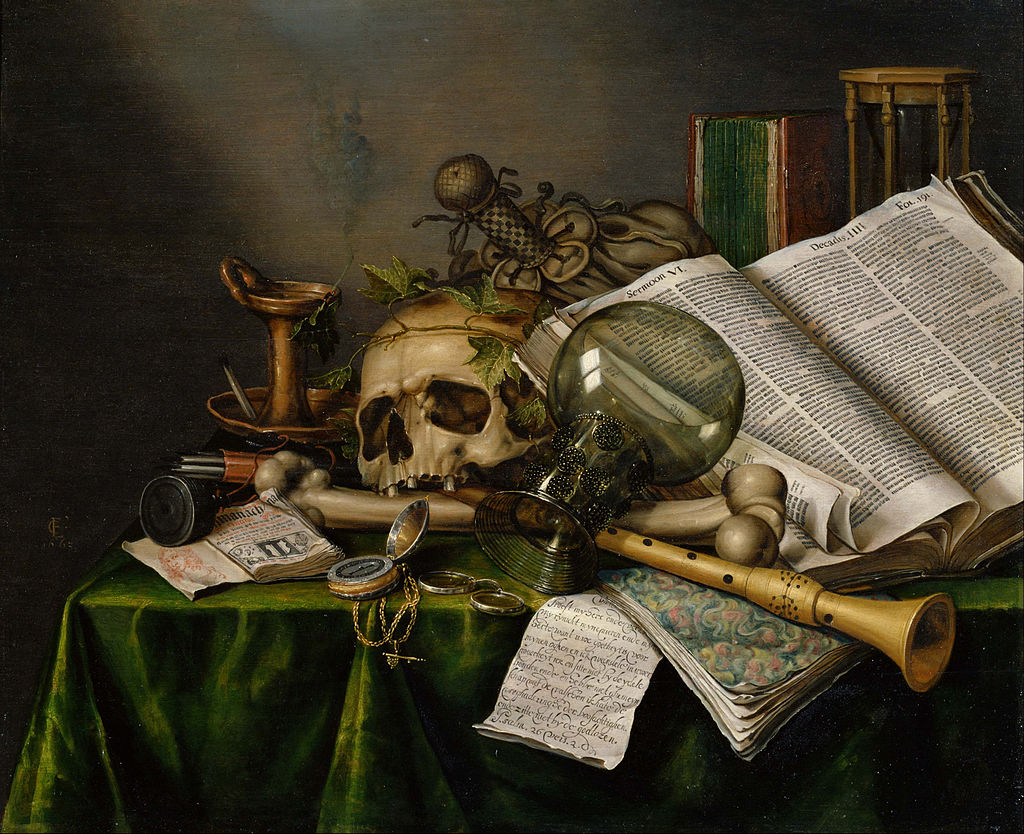The first image I pinned up to spark inspiration for what would eventually be my novel The Flamethrowers was of a woman with tape over her mouth. She floated above my desk with a grave, almost murderous look, war paint on her cheeks, blonde braids framing her face, the braids a frolicsome countertone to her intensity. The paint on her cheeks, not frolicsome. The streaks of it, dripping down, were cold, white shards, as if her face were faceted in icicles. I didn’t think much about the tape over her mouth (which is actually Band-Aids over the photograph, and not over her lips themselves). This image ended up on the jacket of The Flamethrowers, whose first-person narrator, introduced in this issue, in the story “Blanks,” is a young blonde woman. A creature of language, silenced.
The second image was of Ducati engineer Fabio Taglioni standing behind a 1971 750 GT. The Ducati is in metal-flake orange; Taglioni in double-knit Brioni. I didn’t have an image of a girl on a motorcycle, although the book opens with the narrator riding one in the Bonneville land speed trials. Girl on a Motorcycle was the title of a film starring Marianne Faithfull and Alain Delon (which was released in certain European markets, such as Italy, as Naked Under Leather). In the trickiest riding scene, Marianne Faithfull has a double, a hulking man in a honey-blonde wig, as you’ll see if you play it on slow.
The young woman in war paint was from an archival document of 1970s Italy, and she symbolized for me the insurrectionary foment that overtook the country in that decade. “Autonomia” was the term for this foment, the movement of the 1970s, a loose wave of people, all over Italy, who came together for various reason at various times to engage in illegality and play, and to find a way to act, to build forms of togetherness in a country whose working class was impotent and whose sub-working class was fed up with work, by turns joyous and full of rage, ready to revolt, which they did. There were various layers, of which the most violent, shadowy, and clandestine (and yet, paradoxically, the most visible and sensational) were the Red Brigades. The Italian seventies had seemed a logical subject for fiction, on account of the fact that I kept stumbling upon its lore. It all began when I met a mys- terious and magnetic Italian woman who didn’t say much, and who, when I naively asked her what she did, what she was interested in, stared at me and said, “Niente.” She had been the girlfriend of a Red Brigades terrorist, I learned. Her “niente” did not mean “nothing.” It meant, I don’t engage in what you’d call work. Or interests. I might add that I met this woman in a house on Lake Como that was filled with someone’s mother’s Fascist memorabilia, busts of Mussolini, D’Annunzian slogans chiseled into marble.
Which connects to the third image I pinned up as I wrote, of two proper-looking gentlemen in a World War 1–era motorized contraption, an arcane cycle and bullet-shaped sidecar. Of the pair, the man in the sidecar, if passively at the mercy of the one over the handlebars, looks more self-possessed. He looks, actually, like F. T. Marinetti. I pretended that he was, and asked myself, Why did those guys never actually build anything? They drew vehicles on paper. They called war the world’s only hygiene. But they had no relation to engineering and factories, to machines or munitions—except that a few of them lost limbs, or lives, in the war. But so did a lot of regular, non-Futurists.
There are two central threads to The Flamethrowers: Italy in 1977, the crest of the movement, and New York at that time, a period that has long fascinated me, when the city had a Detroit-like feel, was drained of money and its manufacturing base, and piled up with garbage. Parts of downtown became liberated zones of abandonment, populated by artists and criminals. The blackout of 1977 has a special place in my heart—the “bad” blackout, compared to 1965, the “good” blackout, when everyone in the housing projects behaved, an event whose textures DeLillo rendered so memorably in Underworld.
I wanted to conjure New York as an environment of energies, sounds, sensations. Not as a backdrop, a place that could resolve into history and sociology and urbanism, but rather as an entity that could not be reduced because it had become a character, in the manner that a fully complex character in fiction isn’t reducible to cause, reasons, event. I looked at a lot of photographs and other evidentiary traces of downtown New York and art of the mid-1970s. Maybe a person is a tainted magnet and nothing is by chance, but what I kept finding were nude women and guns. The group Up Against the Wall Motherfuckers, who figure in the novel, papered the Lower East Side, in the late 1960s, with posters that said, LOOKING FOR PEOPLE WHO LIKE TO DRAW, with an image of a revolver. I had already encountered plenty of guns in researching Italy—the more militant elements of the Autonomist movement had an official weapon, the Walther P38, which could be blithely denoted with the thumb out, pointer finger angled up. I would scan the images of rallies in Rome, a hundred thousand people, among whom a tenth, I was told by people who had been there, were armed. Ten thousand individuals on the streets of Rome with guns in their pockets. But among New York artists, I hadn’t expected guns, and yet that’s what I encountered: lots of guns, and as I said, lots of nude women. Occasionally in the same image, Hannah Wilke in strappy heels holding a petite purse pistol— like Honey West, except naked. But mostly it was men posing with the guns: William Burroughs, William Eggleston, Sandro Chia, Richard Serra. Warhol’s gun drawings. Chris Burden out in Los Angeles having a friend shoot him. And women with their clothes off: Carolee Schneemann, Hannah Wilke, Francesca Woodman, Ana Mendieta, Marina Abramović, who was both nude and with a loaded gun pointed at her head (by a man). What does all this mean? Many things, I’m sure, but for starters, it means people were getting out of the studio. Art was now about acts not sellable; it was about gestures and bodies. It was freedom, a realm where a guy could shoot off his rifle. Ride his motorcycle over a dry lakebed. Put a bunch of stuff on the floor—dirt, for instance, or lumber. Drive a forklift into a museum, or a functional racecar. But that’s art history. For the purposes of a novel, what did it mean? I was faced with the pleasure and headache of somehow stitching together the pistols and the nude women as defining features of a fictional realm, and one in which the female narrator, who has the last word, and technically all words, is nevertheless continually overrun, effaced, and silenced by the very masculine world of the novel she inhabits—a contra- diction I had to navigate, just as I had to find a way to merge what were by nature static and iconic images into a stream of life, real narrative life.
As I wrote, events from my time, my life, began to echo those in the book, as if I were inside a game of call and response. While I wrote about ultraleft subversives, The Coming Insurrection, a book written by an anonymous French collective, was published in the United States, and its authors were arrested in France. As I wrote about riots, they were exploding in Greece. As I wrote about looting, it was rampant in London. The Occupy movement was born on the University of California campuses, and then reborn as a worldwide phenomenon, and by the time I needed to describe the effects of tear gas for a novel about the 1970s, all I had to do was watch live feeds from Oakland, California.
In 1978, the Red Brigades killed the leader of the Christian Democrats and former prime minister of Italy Aldo Moro. That same year, Guy Debord made his final film, In girum imus nocte et consumimur igni, its title a famous Latin palindrome, translatable as “we turn in the night in a circle of fire.” A film that includes many still images, which I looked at and into as I wrote. Debord’s relationship to women and girls is so strange. He’s suggesting they’ve been used for banal consumer culture, to sell soap, for instance, and yet surely he enjoys seeing them in their bikinis, their young flesh and sweet smiles, as he edits them into the frame. As I was working on the novel, I encountered a woman who was friends with the only Situationist not expelled by Debord, the enigmatic, infamous Gianfranco Sanguinetti. “What is he up to?” I excitedly asked. “What does he do now?” She shrugged, and coolly, disdainfully, said, “He lives.”
A few more films besides Debord’s that were important sources: Barbara Loden’s Wanda, about a young woman who isn’t afraid to throw her life away. Chantal Akerman’s News from Home, in which the camera wanders the deserted streets of Lower Manhattan. Alberto Grifi and Massimo Sarchielli’s Anna, the mother of all films about Italy in the 1970s. Also, a filmic fact: that Taxi Driver was rerated from X to R after the producers scaled back the brightness of reds in the film. Michel Auder’s The Feature, which I saw at Anthology Film Archives, just me and one old man crinkling a paper bag as Auder spent Cindy Sherman’s money on prostitutes, playing himself in a despicable but brilliant game. Before he was married to Sherman, Auder had been with Viva, the Warhol superstar. Viva later dated the photographer William Eggleston, when she was living at the Chelsea Hotel, just after he made Stranded in Canton, in which his Memphis friends waggle guns and hold forth in Quaalude slurs.
An appeal to images is a demand for love. We want something more than just their mute glory. We want them to give up a clue, a key, a way to cut open a space, cut into a register, locate a tone, without which the novelist is lost.
It was with images that I began The Flamethrowers. By the time I finished, I found myself with a large stash.
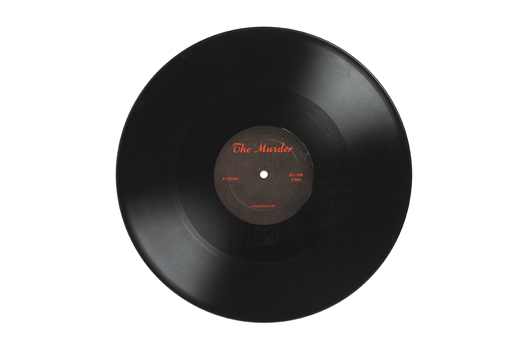
Jack Goldstein, The Murder, 1977, 33 1/3 rpm, 12 minutes.
This twelve-minute record is a montage of sound effects—mostly breaking glass, pouring rain, and thunder. Goldstein had all the right ingredients for myth: brilliant, cool, mysterious. He was hugely influential but ended up living in a trailer in East L.A., selling ice cream from a truck; the ice cream once melted completely when he had to wait in line for methadone, but he refroze it and sold it anyway. He died in 2003, and so his body of work is now, sadly, a bounded set.
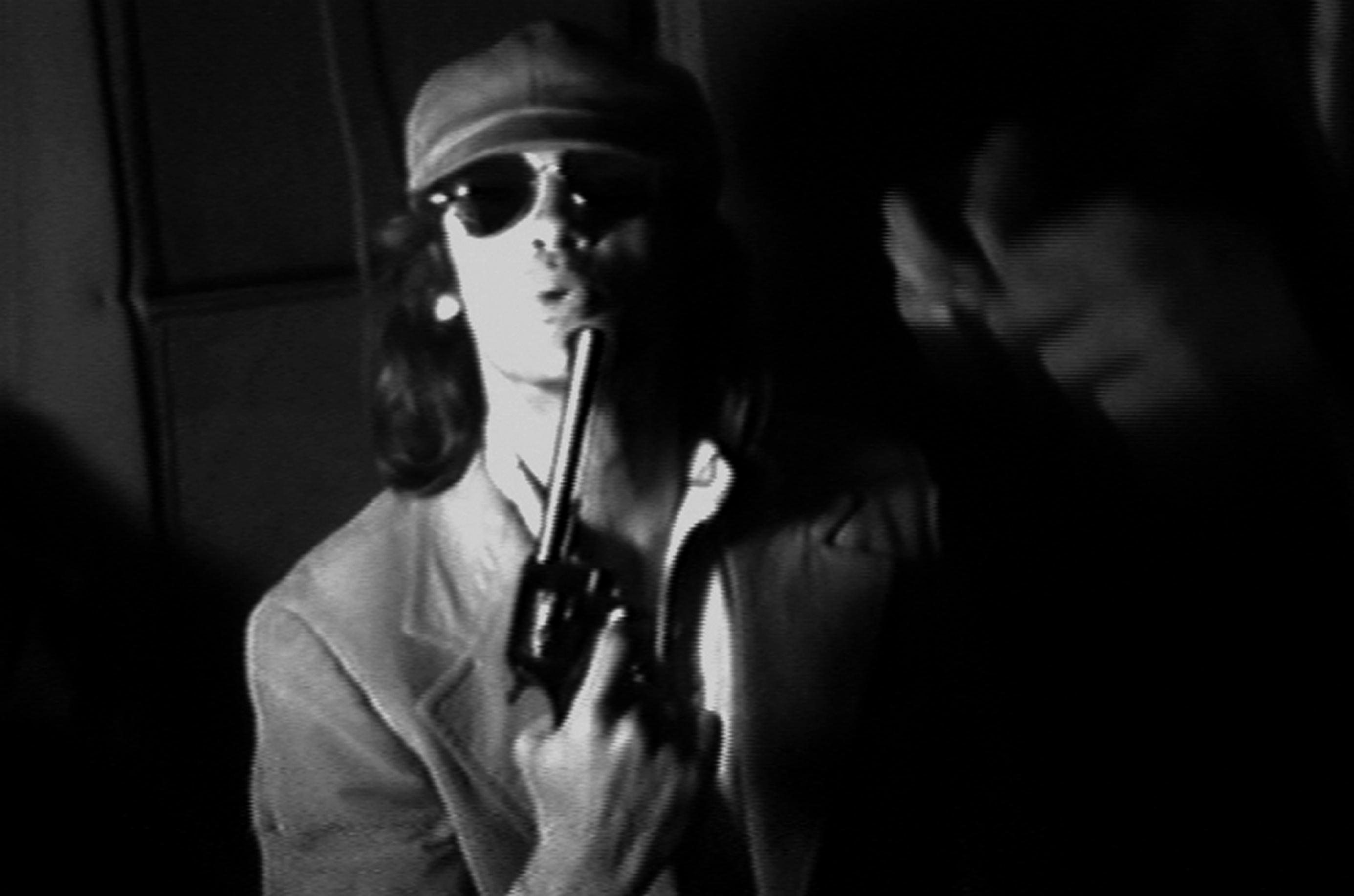 William Eggleston, Stranded in Canton, 1974, still from a black-and-white videotape, 77 minutes.
William Eggleston, Stranded in Canton, 1974, still from a black-and-white videotape, 77 minutes.
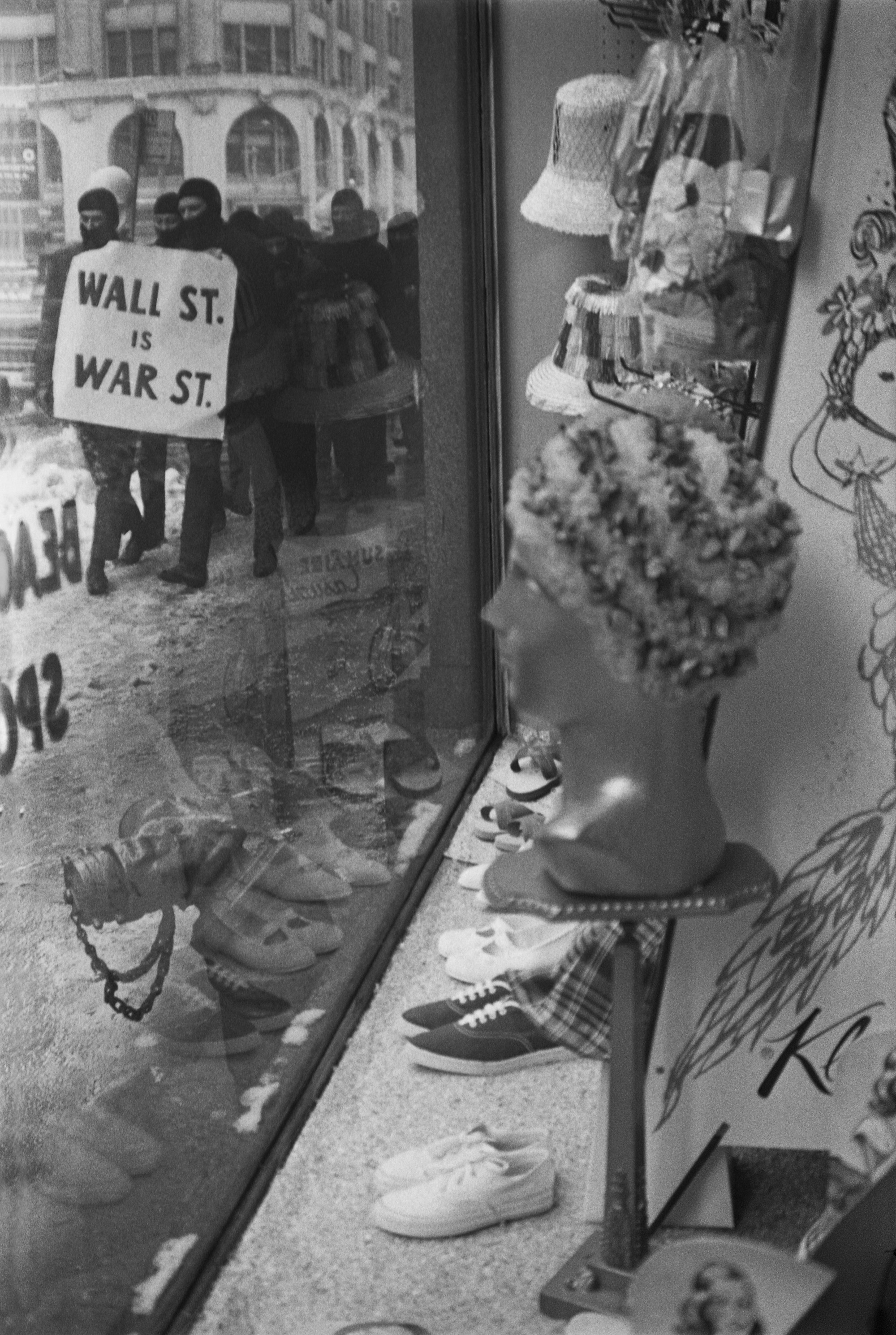 Larry Fink, Black Mask, 1967, black-and-white photograph, 11" x 14".
Larry Fink, Black Mask, 1967, black-and-white photograph, 11" x 14".
Black Mask was a Dada-inspired antiwar movement that intervened in culture and politics and later morphed into Up Against the Wall Motherfuckers, “a street gang with an analysis.” They ran soup kitchens and a free store and tried to empower and motivate the disenfranchised. Their legacy made way for the great culture of East Village artists’s squats like the Gas Station on Avenue B and the Rivington School sculpture garden.
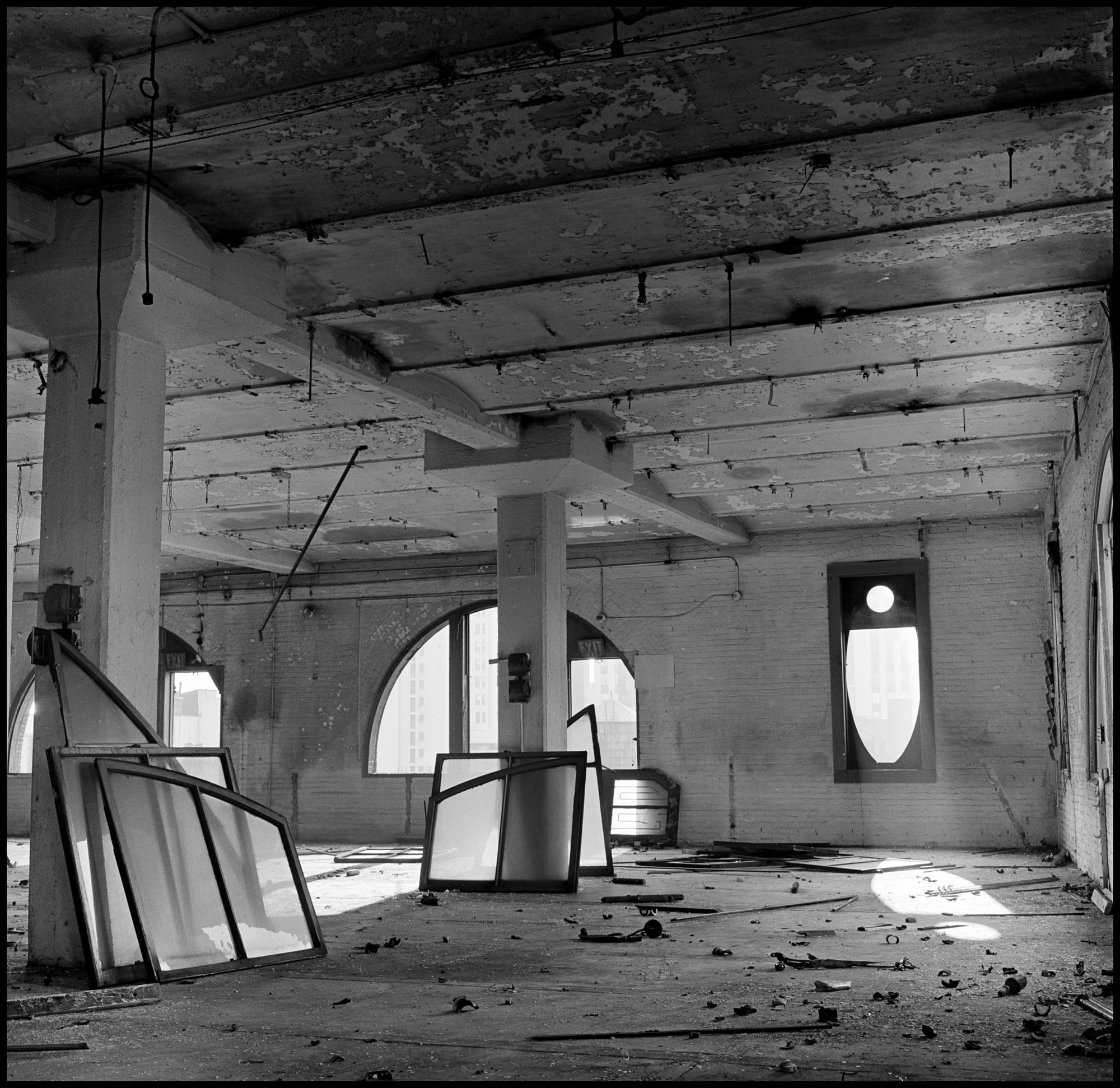 Danny Lyon, 88 Gold Street (detail), 1967, black-and-white photograph, dimensions variable. From the series “The Destruction of Lower Manhattan,” 1967.
Danny Lyon, 88 Gold Street (detail), 1967, black-and-white photograph, dimensions variable. From the series “The Destruction of Lower Manhattan,” 1967.
The same year that Larry Fink photographed Black Mask on Wall Street, Danny Lyon methodically captured with a view camera the vast demolition of Lower Manhattan, much of it coming down for the construction of the Twin Towers. Factories and warehouses to be replaced by finance, which gives literal shape to a significant transformation of the seventies: the death of American manufacturing.
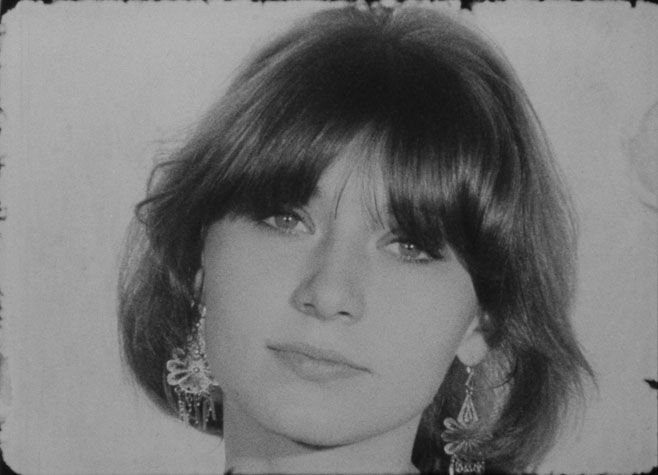 Andy Warhol, Screen Test: Virginia Tusi, 1965, still from a silent black-and-white film in 16mm, 4 minutes at 16 frames per second.
Andy Warhol, Screen Test: Virginia Tusi, 1965, still from a silent black-and-white film in 16mm, 4 minutes at 16 frames per second.
Who is she? No one seems to know. “A young woman identified only as Virginia Tusi,” according to the catalogue raisonné. She was included in Warhol’s Thirteen Most Beautiful Women along with Susanne De Maria and Julie Judd—the exceptionally pretty wives of Walter De Maria and Donald Judd. Warhol’s two favorite kinds of people were beautiful people and the American upper classes. When those were combined into one person, such as Edie Sedgwick, bliss. One of the more striking men that Warhol filmed in 1965 was in the audience when I saw a program of Screen Tests last year. This man, a beard now tumbling down his chin, big belly protruding from his open blazer, shared anecdotes. “Warhol wanted me to flex my jaw,” he said. And, “Edie was a real bitch.” It might be better if Virginia Tusi just keeps beaming resplendently from her Screen Test, a mystery of mute loveliness.
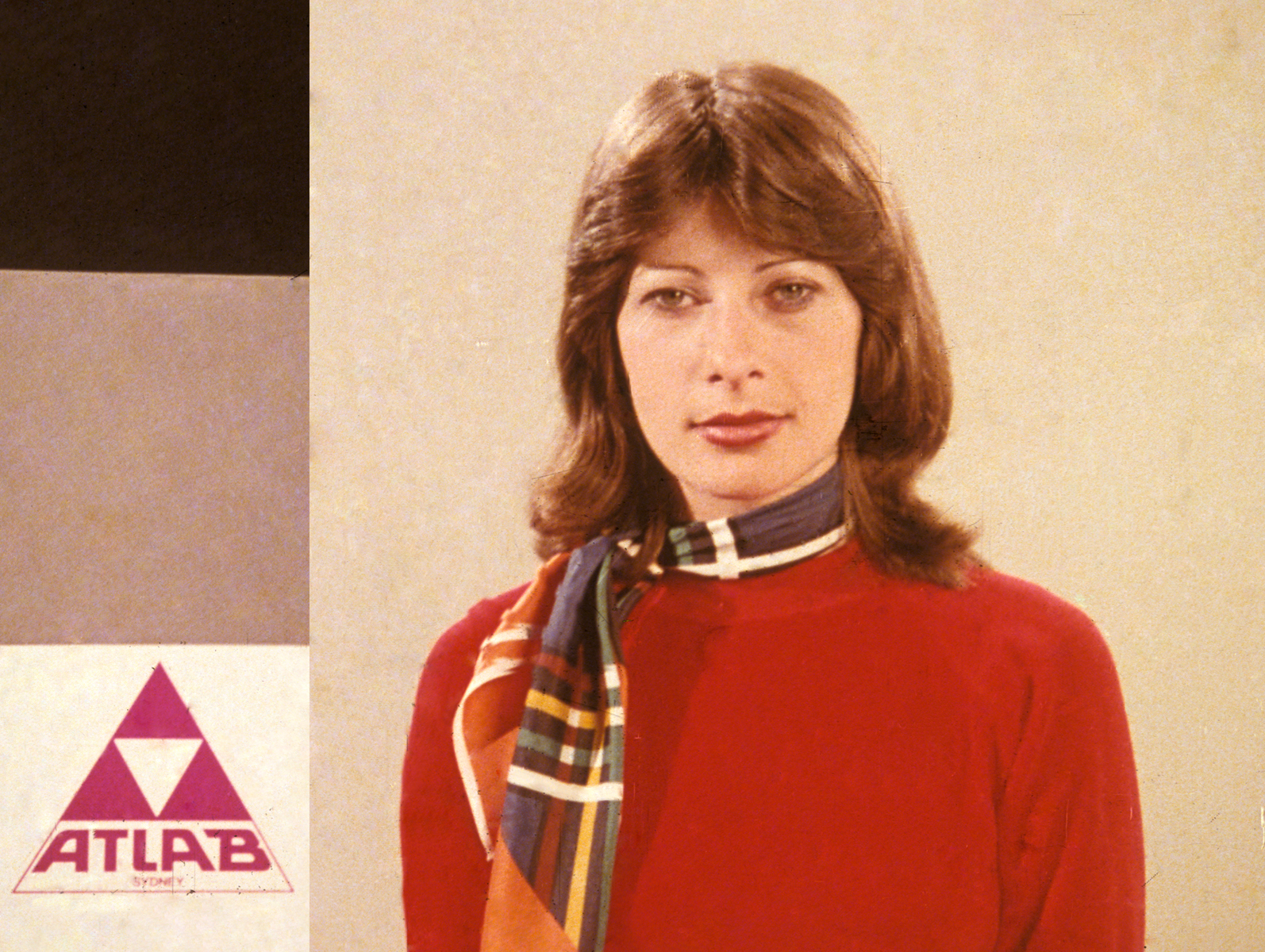 Julie Buck and Karin Segal, China Girl #56, 2005, digital print from a color film, 12" x 15". From the series “Girls on Film,” 2005.
Julie Buck and Karin Segal, China Girl #56, 2005, digital print from a color film, 12" x 15". From the series “Girls on Film,” 2005.
China girls, whose faces were used to adjust color densities in film processing, were mostly secretaries who worked in the film labs—regular women who appeared on leader that was distributed all over the world. It’s not clear why they had that rather racist moniker; some say the original ones were Asian, and others speculate that a particular secretary who posed for film leader was a habitual server of tea (which makes the name seem even more problematic). In France, they were “les lillis.” If the projectionist loaded the film correctly, you didn’t see the China girl. And if you did see her, she flashed by so quickly she was only a quick blur. They were ubiquitous and yet invisible, a thing in the margin that was central to each film, these nameless women that, as legend has it, were traded among film technicians and projectionists like baseball cards.
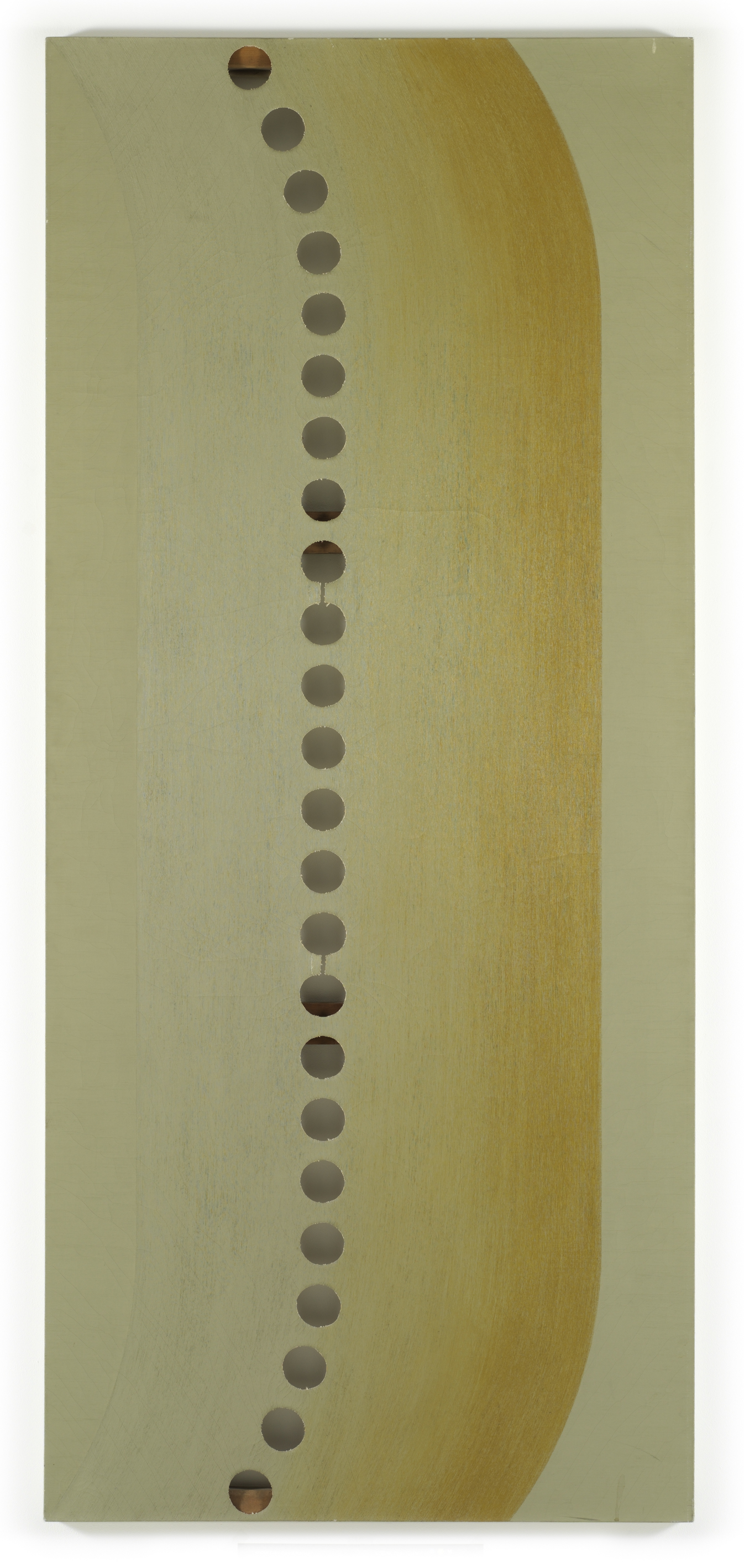 Lee Lozano, Punch, Peek & Feel, 1967-70, oil on canvas with perforations, 95 5/8" x 42 1/8" x 1 5/8".
Lee Lozano, Punch, Peek & Feel, 1967-70, oil on canvas with perforations, 95 5/8" x 42 1/8" x 1 5/8".
Lozano was a tough and uncompromising person, celebrated by her male contemporaries for her conceptually driven paintings and the way she collapsed art into life. She had a solo show at the Whitney in 1970. In 1971, for her piece Decide to Boycott Women, she did just that: she didn’t speak to women for the next twenty-eight years, right up until her death.
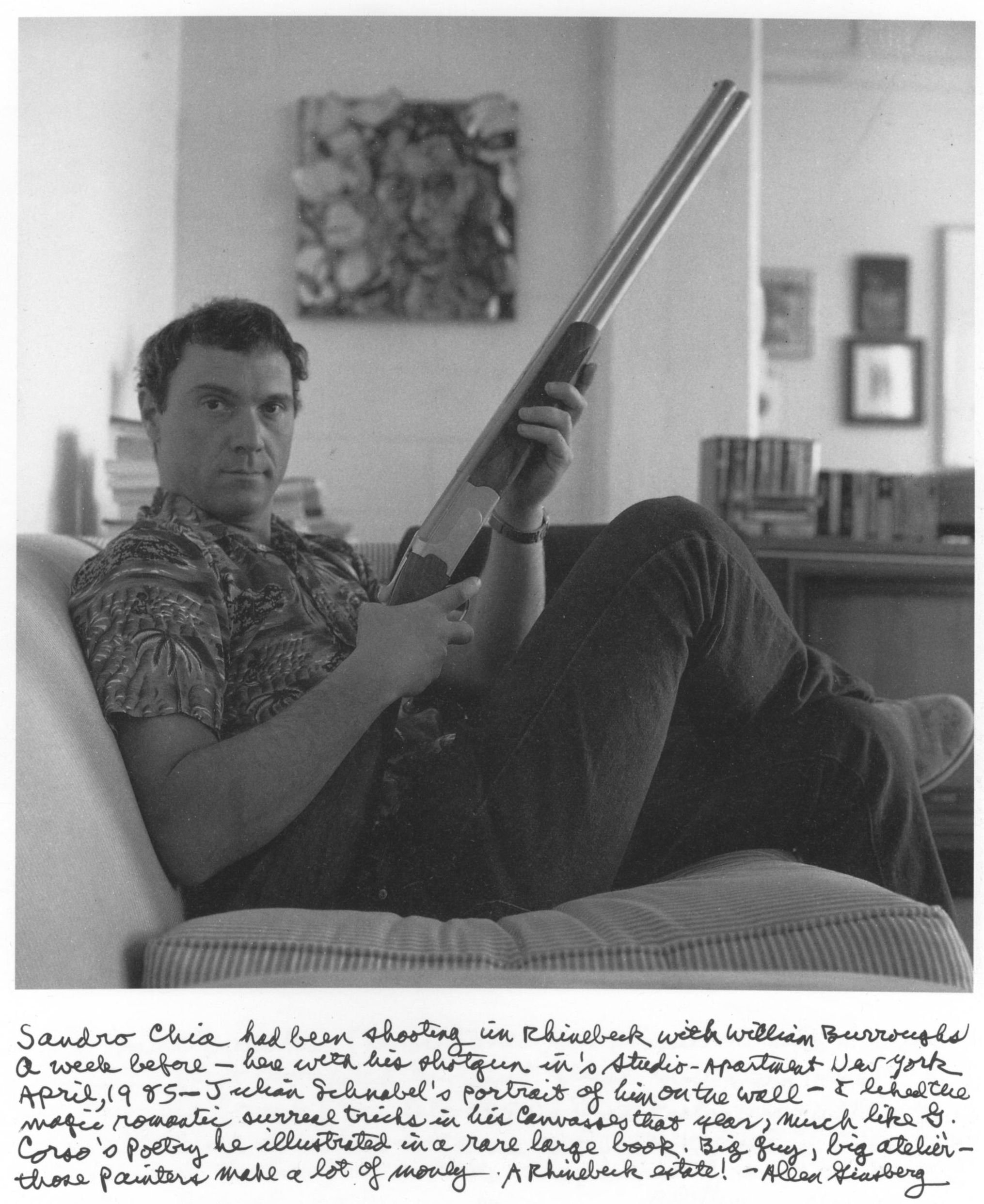 Allen Ginsberg, Sandro Chia (detail), 1985, black-and-white photograph, 11" x 14".
Allen Ginsberg, Sandro Chia (detail), 1985, black-and-white photograph, 11" x 14".
“In a serious confrontation, I’d take a shotgun any day. It’s a much more formidable and effective weapon than a handgun, unless it’s a hand shotgun. I’d like to see more of those,” wrote William Burroughs. The artist Sandro Chia had been firing at targets with Burroughs in Rhinebeck, New York, when this photograph was taken.
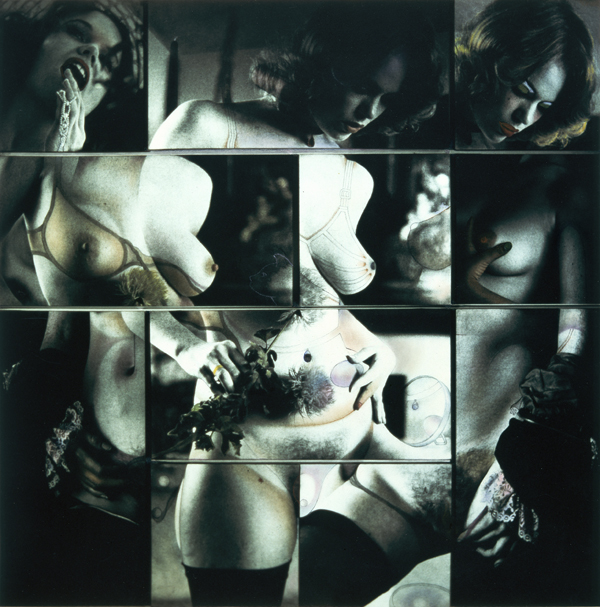 Robert Heinecken, Cliché Vary: Autoeroticism, 1974, photographic emulsion on canvas and pastel chalk, 39 1/2" x 39 1/2".
Robert Heinecken, Cliché Vary: Autoeroticism, 1974, photographic emulsion on canvas and pastel chalk, 39 1/2" x 39 1/2".
The sweet innocence of the McLuhan seventies. By the 1980s, when I was a teenager, I carried around a copy of Subliminal Seduction: Are You Being Sexually Aroused by This Picture? and thought I was being very ironic and clever. The culture by that point was already using the ability to decode to sell us to ourselves in even more effective ways. Selling us sex. Even as sex was, is, and will be one of the few things people can do to each other for free.
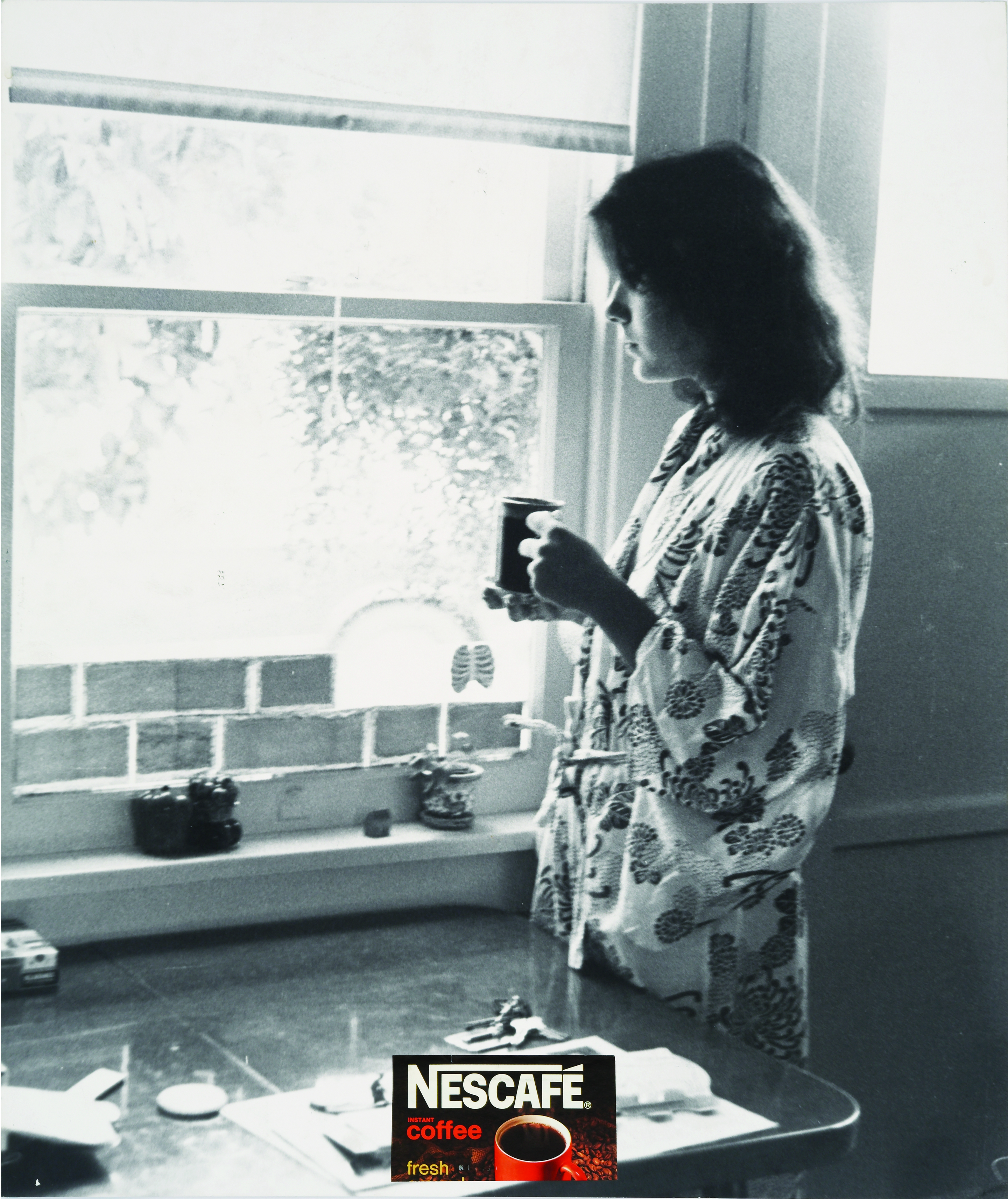 David Salle, The Coffee Drinkers, 1973, black-and-white photograph with affixed product advertisement, one of four panels, each 20" x 16".
David Salle, The Coffee Drinkers, 1973, black-and-white photograph with affixed product advertisement, one of four panels, each 20" x 16".
She’s having a quiet, contemplative moment in morning light. She’s selling coffee. Or coffee’s selling her, as her, or as … lifestyle? Something feminine, calming, pure? “Images that understand us” was a phrase coined by Salle and James Welling. Salle, as a twenty-one-year-old student, made a prescient series of images—well before we came to know work by Richard Prince or Cindy Sherman—by photographing four women in his life (among them his girlfriend and mother) and gluing on the Nescafé label.
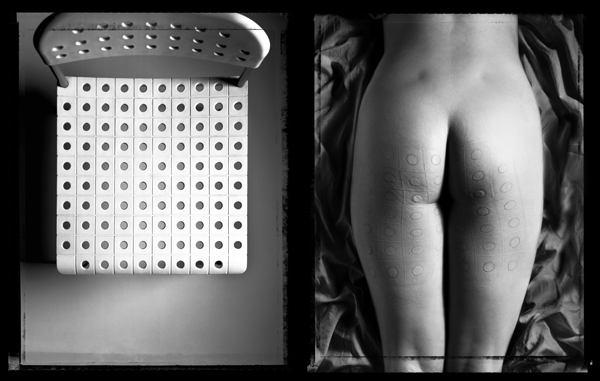 Gabriele Basilico, Contact, 1984, two black-and-white photographs, 23 5/8" x 31 7/8".
Gabriele Basilico, Contact, 1984, two black-and-white photographs, 23 5/8" x 31 7/8".
“Putting together chairs and bottoms was very enjoyable for me,” Basilico has said of his series Contact. He calls the residual marks from this process “provisional relief tattoos.” But tattoos of what? Modernism, as painless as modernism looks but never is. The link between violence and modernism is everywhere but too broad to get into in the form of a caption. It’s something more like a life’s work. Someone’s, anyhow, if not mine.
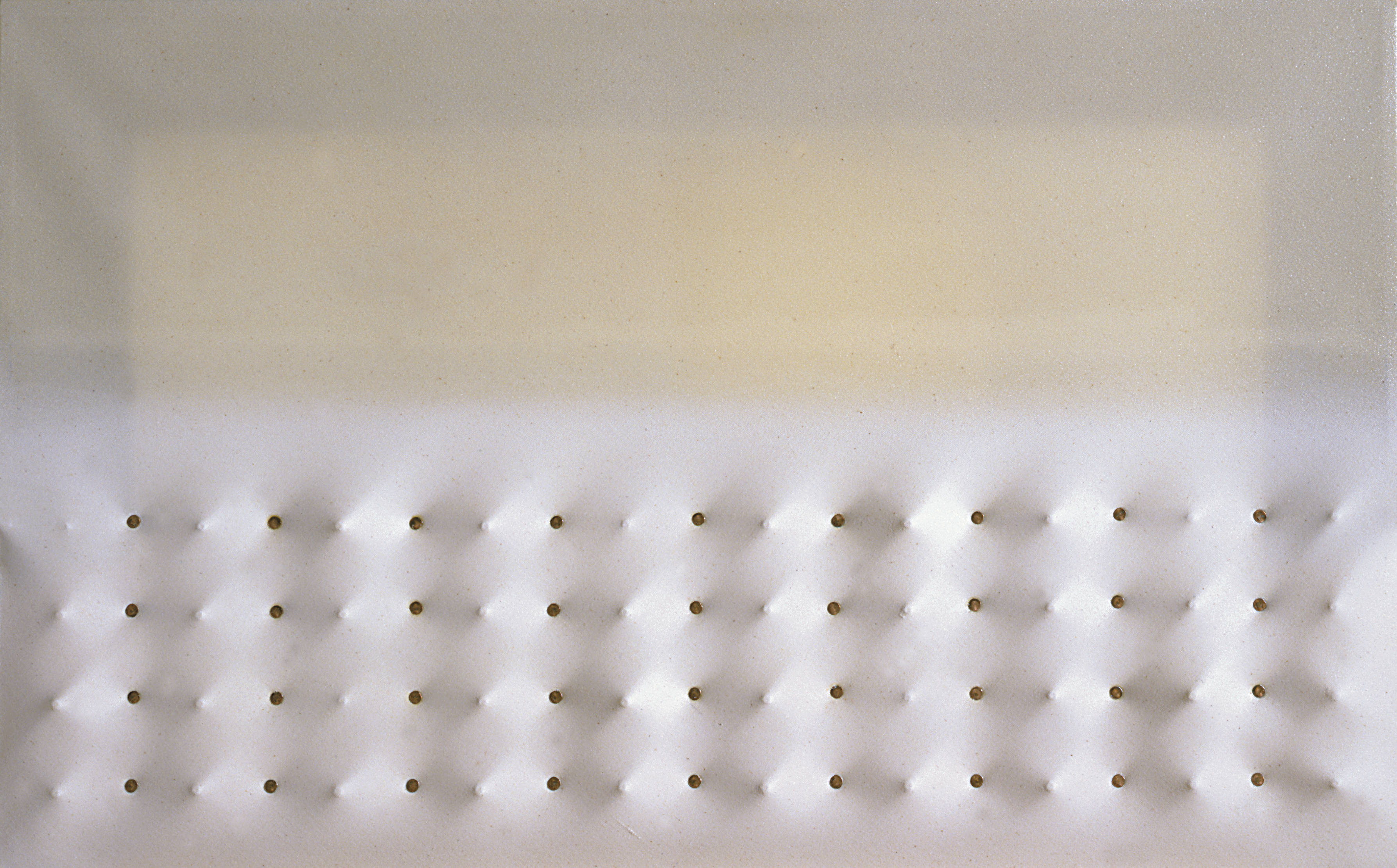 Enrico Castellani, Superficie, 2008, resin on canvas, 19 3/4" x 31 1/2".
Enrico Castellani, Superficie, 2008, resin on canvas, 19 3/4" x 31 1/2".
Enrico Castellani, a younger contemporary of Lucio Fontana and Alberto Burri, was the first person in Italy targeted in the massive sweep of arrests in the seventies. Castellani seems to have circulated among leftists. A recent catalogue of his work includes an essay by Adriano Sofri, former leader of the leftist group Lotta Continua, who spent twenty-two years in prison for instigating the assassination of a police captain (Sofri vehemently maintains his innocence).
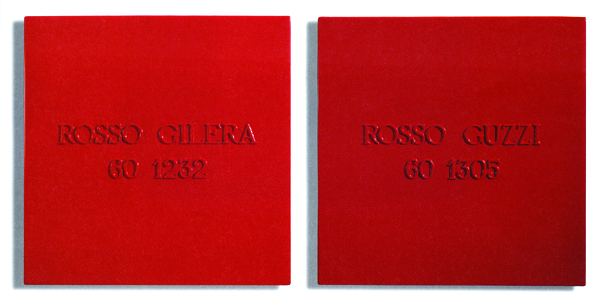 Alighiero Boetti, Rosso Gilera, Rosso Guzzi, 1967, enamel paint on two iron panels, each 27 9/16" x 27 9/16".
Alighiero Boetti, Rosso Gilera, Rosso Guzzi, 1967, enamel paint on two iron panels, each 27 9/16" x 27 9/16".
Boetti makes a series of works using industrial paints, like in this case, colors used for motorcycle makes Gilera and Moto Guzzi. The point wasn’t merely that colors had been branded. Factory politics in Italy were about to erupt, in the “hot autumn” of 1969. Meanwhile the fastest bikes in the world were being produced in Northern Italy, where Boetti was from. In Rosso Gilera, Rosso Guzzi, speed, racing, conceptual and formal precepts, and an industrialized but not yet subjectivized class of workers collide and simmer, all in a work that looks so friendly, uncomplicated, and Pop.
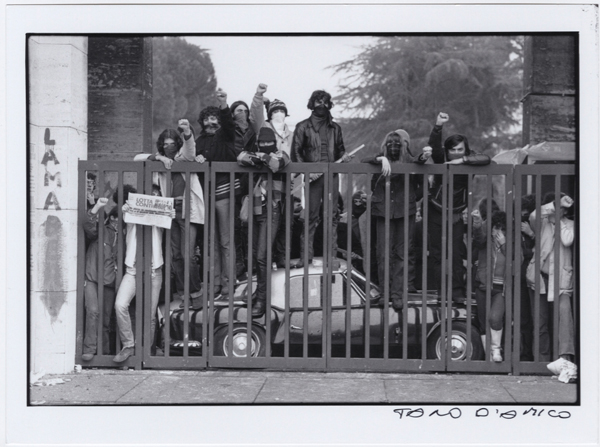 Tano D’Amico, At the Gates of the University, 1977, black-and-white photograph, each 7" x 9 3/8".
Tano D’Amico, At the Gates of the University, 1977, black-and-white photograph, each 7" x 9 3/8".
Go to Italy and no one talks about the 1970s, when their country literally almost had a revolution. That explosive era and its joys, traumas, and failures have been all but erased. Luckily, there are some remainders, like the amazing photographs of Tano D’Amico. Here, he captures students at the gates of Sapienza University in Rome on February 17, 1977, when it was occupied by students, as Luciano Lama, leader of the biggest labor union in Italy, came to pay them a visit and was heckled and expelled.
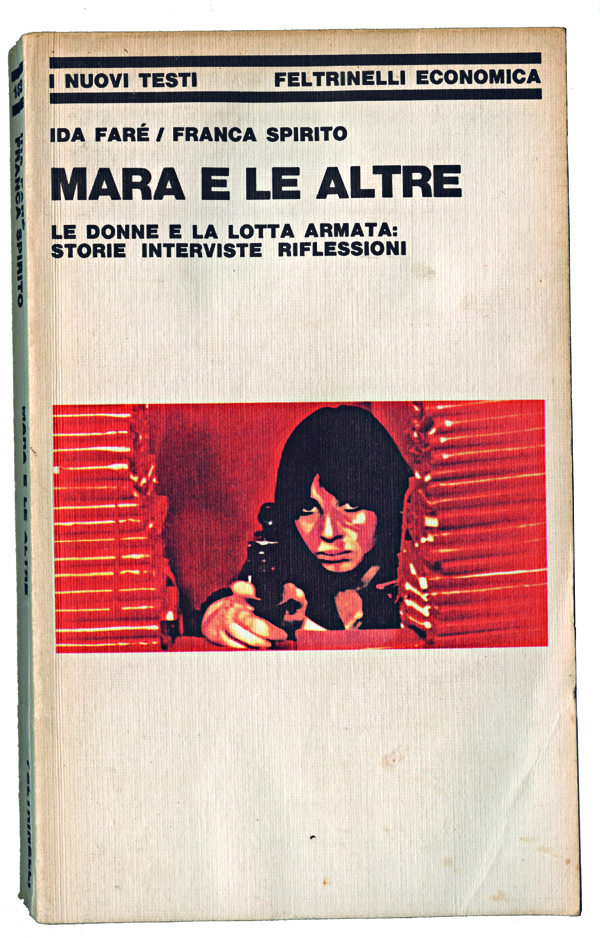 Ida Faré and Franca Spirito’s Mara e Le Altre, 1979.
Ida Faré and Franca Spirito’s Mara e Le Altre, 1979.
“Mara” is Mara Cagol, a former leader of Italy’s leftist-militant Brigate Rosse (BR). “Le altre” are the militant women in Italy in the 1970s, whose Leninism and bombs were only one small and contested facet of a vast and complex wave of feminist actions that transformed the landscape of Italy and are of great interest still to feminist theorists for their sophistication and lucidity. It’s curious that for the cover of this book an image from Godard’s 1967 film La Chinoise was chosen. Not an image of a real female terrorist, of which Italy produced many, but a still from a film where an actress (Juliet Berto) plays a terrorist, crouching behind a machine-gun turret built of stacked copies of Mao’s little red book. The real terrorist, Mara Cagol, successfully broke her husband from prison, fellow BR leader Renato Curcio, in 1975. The same year, she was gunned down in a shoot-out with carabinieri. The founder of Feltrinelli, the press that published this book, had died accidentally in 1972, attempting to sabotage Milan’s power supply.
Read our interview with the author. The Flamethrowers is in stores now.

